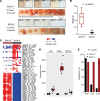DNA promoter hypermethylation of melanocyte lineage genes determines melanoma phenotype
- PMID: 36040798
- PMCID: PMC9675437
- DOI: 10.1172/jci.insight.156577
DNA promoter hypermethylation of melanocyte lineage genes determines melanoma phenotype
Abstract
Cellular stress contributes to the capacity of melanoma cells to undergo phenotype switching into highly migratory and drug-tolerant dedifferentiated states. Such dedifferentiated melanoma cell states are marked by loss of melanocyte-specific gene expression and increase of mesenchymal markers. Two crucial transcription factors, microphthalmia-associated transcription factor (MITF) and SRY-box transcription factor 10 (SOX10), important in melanoma development and progression, have been implicated in this process. In this study we describe that loss of MITF is associated with a distinct transcriptional program, MITF promoter hypermethylation, and poor patient survival in metastatic melanoma. From a comprehensive collection of melanoma cell lines, we observed that MITF-methylated cultures were subdivided in 2 distinct subtypes. Examining mRNA levels of neural crest-associated genes, we found that 1 subtype had lost the expression of several lineage genes, including SOX10. Intriguingly, SOX10 loss was associated with SOX10 gene promoter hypermethylation and distinct phenotypic and metastatic properties. Depletion of SOX10 in MITF-methylated melanoma cells using CRISPR/Cas9 supported these findings. In conclusion, this study describes the significance of melanoma state and the underlying functional properties explaining the aggressiveness of such states.
Keywords: Cell Biology; Melanoma; Oncology.
Figures






References
-
- Mehta A, et al. Immunotherapy resistance by inflammation-induced dedifferentiation. Cancer Discov. 2018;8(8):935–943. doi: 10.1158/2159-8290.CD-17-1178. - DOI - PMC - PubMed
Publication types
MeSH terms
Substances
LinkOut - more resources
Full Text Sources
Medical
Molecular Biology Databases

